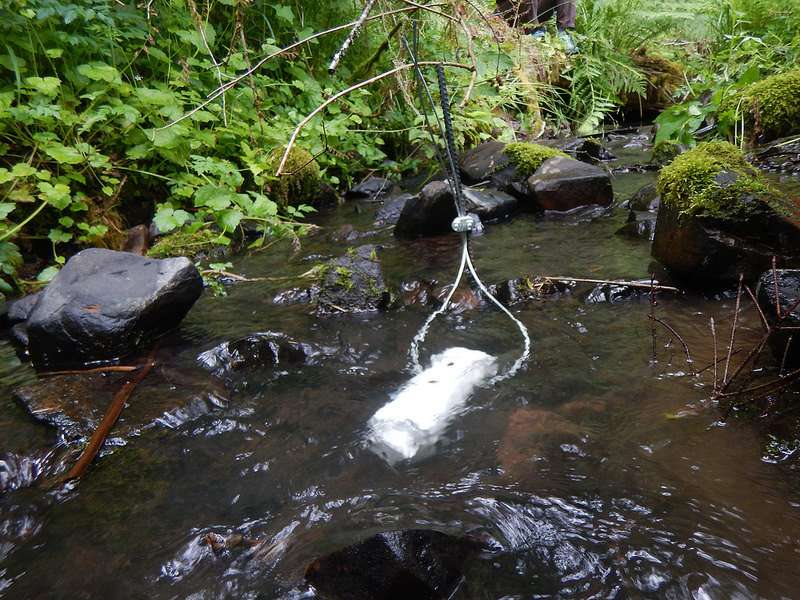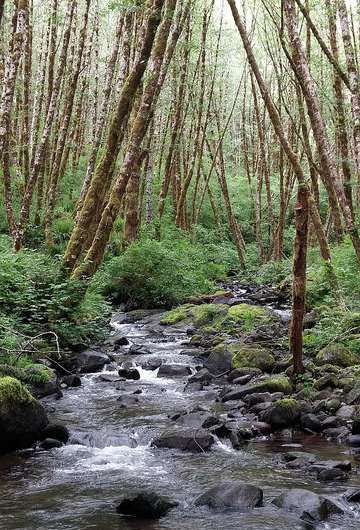When it comes to keeping streams cool, buffer strips help but geology rules

Leaving a strip of trees along headwater streams during logging operations helps to keep the water cool, but researchers have now shown that the downstream impacts of such practices have more to do with geology than with the presence or width of buffer strips.
Using studies in three Oregon watersheds—Alsea, Trask and Hinkle Creek—scientists analyzed the impact of buffer strips on downstream temperatures. The researchers used data recorded in experiments carried out in 27 locations over 14 years. The results of the analysis, one of the most robust of its kind in the nation, were reported in the journal Hydrological Processes.
The Alsea and Trask watersheds are located in the Oregon Coast Range near Alsea and Tillamook respectively. The Hinkle Creek watershed is located northeast of Roseburg in the Cascade foothills.
"In Coast Range and Western Cascades catchments, where our study streams were located, streams that are small and non-fish bearing have no regulatory requirement for an overstory riparian buffer," said Kevin Bladon, lead author and assistant professor in the College of Forestry at Oregon State University. "As a result, we observed some warming of the stream water. However, if the geology is permeable—where we have a lot of groundwater inputs into the system—that warm water didn't persist downstream. As soon as it flowed back into a forested stream reach again, the temperature stabilized."
Based on isolated research efforts, scientists have reached different conclusions about the impact of harvesting on stream temperatures and how far those impacts can be detected downstream. "This study, with 29 different sites across multiple catchments, upstream and downstream in different geologies, provides a lot of strong evidence" about how the environment determines the impacts of logging on downstream temperatures, said Bladon.
"Stream temperature is one of those things that people tend to think is simple and easy to measure," he added. "However, the dynamics and all of the factors that influence it are quite complicated. Temperatures aren't just influenced by exposure of water to the sun. They depend on things like whether the water flows through the stream bed or through a stream bank, the geometry of the stream channel, how much water there is in the stream channel, and how much groundwater input there is."

In the experiments Bladon and his team analyzed, stream temperatures were recorded during low-flow conditions from July to September in headwater streams above and below locations where harvesting operations were conducted. The locations provided a variety of geology, landscape and forest-management circumstances.
All three watersheds contain fish-bearing reaches. While cutthroat trout are the primary fish species at Hinkle Creek, the Trask and Alsea watersheds are home to populations of coho salmon, steelhead, cutthroat trout and sculpin. Alsea also has runs of western brook and Pacific lamprey.
In Oregon, private forest regulations require loggers to leave buffer strips of trees along fish-bearing streams, medium and large non-fish-bearing streams and domestic water sources. The exact width depends on the size of the stream channel and the fish species present.
"We've been talking for a lot of years about riparian areas. The discussion can get really heated," said Bladon. "I think a lot of folks would like to move toward a variable-width riparian area system. Right now, it's categorized. If it's a fish-bearing stream of a certain size, you will use a specific width riparian area.
"In terms of stream temperature, in some cases, it's not enough, and in others, it's overkill. But, we definitely need more research to figure out where those places are."
While this research provides important insights into the downstream movement of warmed stream water, the experiments analyzed by Bladon and his team were not initially set up to directly address these types of questions. As a result, he and other Oregon State researchers are conducting additional studies. They are placing sensors at short intervals in undisturbed streams and in streams that will be harvested to determine precisely how temperatures change downstream from harvesting operations.
Provided by Oregon State University
















